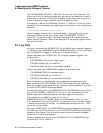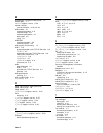Troubleshooting eSNMP Problems
6.2 Modifying the Subagent Timeout
The TCPIP$ESNMP_DEFAULT_TIMEOUT value is from 0 to 60 seconds. (You
should use 0 only for testing purposes, such as simulating problems on a heavily
loaded host or network.) If the value you specify contains nonnumeric digits or is
outside the allowed range, the default value of 3 seconds is used.
For example, to define TCPIP$ESNMP_DEFAULT_TIMEOUT to time out after 6
seconds of inactivity between the master agent and subagents, enter the following
command:
$ DEFINE/SYSTEM TCPIP$ESNMP_DEFAULT_TIMEOUT 6
When a subagent registers with the master agent, it can specify a value that
overrides the value you set with logical name TCPIP$ESNMP_DEFAULT_
TIMEOUT. The standard MIB II and Host Resources MIB subagents use the
default value of 3 seconds. Refer to the description of the esnmp_register routine
for more information.
6.3 Log Files
All output redirected from SYS$OUTPUT for the SNMP agent process is logged to
*.LOG files in the SYS$SYSDEVICE:[TCPIP$SNMP] directory. Output redirected
from SYS$ERROR is logged to *.ERR files in the same directory.
Output redirected from SYS$OUTPUT for the agent process is logged to the
following files:
• TCPIP$ESNMP.LOG (for the master agent)
• TCPIP$OS_MIBS.LOG (for the MIB II)
• TCPIP$HR_MIB.LOG (for the Host Resources MIB)
Output redirected from SYS$ERROR is logged to the following files:
• TCPIP$ESNMP.ERR (for the master agent)
• TCPIP$OS_MIBS.ERR (for the MIB II)
• TCPIP$HR_MIB.ERR (for the Host Resources MIB)
Data is flushed to the log files when the corresponding process terminates.
Each invocation of the TCPIP$SNMP_RUN.COM procedure purges these files,
retaining at least the last seven versions (the exact number depends on the value
of the CLUSTER_NODES system parameter).
The log files are located in the SYS$SYSDEVICE:[TCPIP$SNMP] directory along
with the TCPIP$SNMP_CONF.DAT file, which is a text representation of the
SNMP configuration data generated by the master agent during startup.
The contents of the SNMP log files are written to
SYS$SYSDEVICE:[TCPIP$SNMP] when the process stops or when you stop
it (for example, by entering the STOP/ID=xxx command). After a process restarts,
it creates a new version of the files. If a process executes without errors, *.ERR
files might not be created.
Writing to SYS$OUTPUT and SYS$ERROR from custom subagents is controlled
by qualifiers on the RUN command in the TCPIP$EXTENSION_MIB_RUN.COM
procedure. See Chapter 3 for information about including extension subagent
commands in the startup procedure.
Custom subagents that do not write to SYS$OUTPUT and SYS$ERROR might
not produce a .LOG or .ERR file.
6–2 Troubleshooting eSNMP Problems


















